Caused by burrowing mite - Study guides, Class notes & Summaries
Looking for the best study guides, study notes and summaries about Caused by burrowing mite? On this page you'll find 96 study documents about Caused by burrowing mite.
Page 4 out of 96 results
Sort by
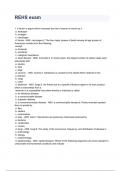
-
REHS exam With Correct Answers
- Exam (elaborations) • 27 pages • 2024
-
- $15.49
- + learn more
REHS exam 1. A factor or agent which increases the risk of cancer is known as a a. teratogen b. mutagen c. carcinogen d. fomite - ANS carcinogen;2. The four major causes of death among all age groups of Americans include all of the following except. a. homicide b. accidents c. malignant neoplasms d. heart disease - ANS homicide;3. In recent years, the largest number of rabies cases were associated with a. skunks b. bats c. dogs d. raccons. - ANS skunks;4. Asbes...
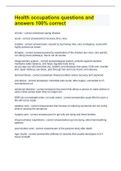
-
Health occupations questions and answers 100% correct
- Exam (elaborations) • 14 pages • 2022
- Available in package deal
-
- $11.99
- + learn more
Health occupations questions and answers 100% correctchronic on-going disease acute short recovery time, virus 00:03 01:17 scabies rash, caused by burrowing mite, very contagious, cured with highly poisionous cream shingles caused by reactivation of the chicken pox virus, very painful, run along nerve pathways, has to run its course integumentary system largest system, protects against bacteria, maintains water balance, and helps regulate body temp. as y...
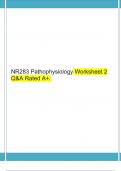
-
NR283 Pathophysiology Worksheet 2 Q&A Rated A+.
- Exam (elaborations) • 18 pages • 2023
-
- $19.99
- + learn more
NR283 Pathophysiology Worksheet 2 Q&A Rated A+. Worksheet 2 NR283 Pathophysiology Worksheet 2 Q&A Rated A+. Questions: 1. Define epidermis, dermis, and subcutaneous tissue. • Epidermis: Consists of 5 layers that vary in thickness @ different areas of the body; no blood vessels or nerves are present; contains melanocytes (specialized pigment-producing cells);5 layers include: stratum basale (innermost layer located on the basement membrane and only layer where mitosis occurs), stra...

-
(TEAE) EXAM PRACTICE STUDY GUIDES
- Exam (elaborations) • 7 pages • 2023
-
- $8.99
- + learn more
TDLR (TEAE) EXAM PRACTICE STUDY GUIDES Telegen lashes - CORRECT ANSWER-Final phase in the growth cycle ready to shed. Lashes are the longest, dark & course. A disease caused by bacteria that are transmitted through coughing or sneezing - CORRECT ANSWER-Tuberculosis Two common type of eye shapes - CORRECT ANSWER-Rounded or oblong (almond) Demodex mite - CORRECT ANSWER-Microscopic mites burrowing into the follicle of the eyelash, eyebrow follicle that can cause blepharitis. Pediculosis...
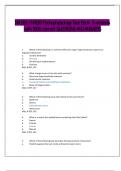
-
NR 283 / NR283 Pathophysiology Test Bank 3 versions with 100% correct QUESTIONS AND ANSWERS
- Exam (elaborations) • 161 pages • 2023
-
- $20.49
- + learn more
NR 283 / NR283 Pathophysiology Test Bank 3 versions with 100% correct QUESTIONS AND ANSWERS 1. Which of the following is a common effect of a type I hypersensitivity response to ingested substances? a. Contact dermatitis b. Urticaria c. Discoid lupus erythematosus d. Psoriasis ANS: B REF: 145 2. What change occurs in the skin with psoriasis? a. Recurrent hypersensitivity reactions b. Autoimmune response c. Increased mitosis and shedding of epithelium d. Basal cell degeneratio...

-
NR 283 / NR283 Pathophysiology Test Bank 3 versions with 100% correct QUESTIONS AND ANSWERS
- Exam (elaborations) • 161 pages • 2023
-
- $20.49
- + learn more
NR 283 / NR283 Pathophysiology Test Bank 3 versions with 100% correct QUESTIONS AND ANSWERS 1. Which of the following is a common effect of a type I hypersensitivity response to ingested substances? a. Contact dermatitis b. Urticaria c. Discoid lupus erythematosus d. Psoriasis ANS: B REF: 145 2. What change occurs in the skin with psoriasis? a. Recurrent hypersensitivity reactions b. Autoimmune response c. Increased mitosis and shedding of epithelium d. Basal cell degeneratio...

-
NR 283 / NR283 Pathophysiology Test Bank 3 versions with 100% correct QUESTIONS AND ANSWERS
- Exam (elaborations) • 161 pages • 2023
-
- $21.89
- + learn more
NR 283 / NR283 Pathophysiology Test Bank 3 versions with 100% correct QUESTIONS AND ANSWERS 1. Which of the following is a common effect of a type I hypersensitivity response to ingested substances? a. Contact dermatitis b. Urticaria c. Discoid lupus erythematosus d. Psoriasis ANS: B REF: 145 2. What change occurs in the skin with psoriasis? a. Recurrent hypersensitivity reactions b. Autoimmune response c. Increased mitosis and shedding of epithelium d. Basal cell degeneratio...
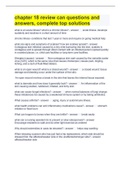
-
chapter 18 review can questions and answers, complete top solutions
- Exam (elaborations) • 4 pages • 2023
-
Available in package deal
-
- $8.99
- + learn more
chapter 18 review can questions and answers, complete top solutions what is an acute illness? what is a chronic illness? acute illness- develops suddenly and resolves in a short amount of time chronic illness- conditions that last 1 year or more and require on going medical help what are signs and symptoms of scabies? how are scabies spread? Contagious skin infection caused by a tiny mite burrowing into the skin, scabies is contagious and is spread through direct contact with an inf...
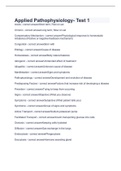
-
Applied Pathophysiology- Test 1 2023 with 2023 with 100% correct questions and answers
- Exam (elaborations) • 12 pages • 2023
-
- $15.99
- + learn more
Acute Short term; Fast on set Chronic Long term; Slow on set Compensatory Mechanism Physiological response to homeostatic imbalance (Positive or negative feedback mechanism) Congenital Born with Etiology Cause of disease Homeostasis Body natural balance Iatrogenic Unintended affect of treatment Idiopathic Unknown cause of disease Manifestation Signs and symptoms Pathophysiology Development and evolution of disease Pr...
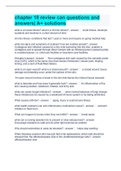
-
chapter 18 review can questions and answers| A+ solutions
- Exam (elaborations) • 4 pages • 2023
-
- $7.99
- + learn more
chapter 18 review can questions and answers| A+ solutions what is an acute illness? what is a chronic illness? acute illness- develops suddenly and resolves in a short amount of time chronic illness- conditions that last 1 year or more and require on going medical help what are signs and symptoms of scabies? how are scabies spread? Contagious skin infection caused by a tiny mite burrowing into the skin, scabies is contagious and is spread through direct contact with an infected pers...

That summary you just bought made someone very happy. Also get paid weekly? Sell your study resources on Stuvia! Discover all about earning on Stuvia


